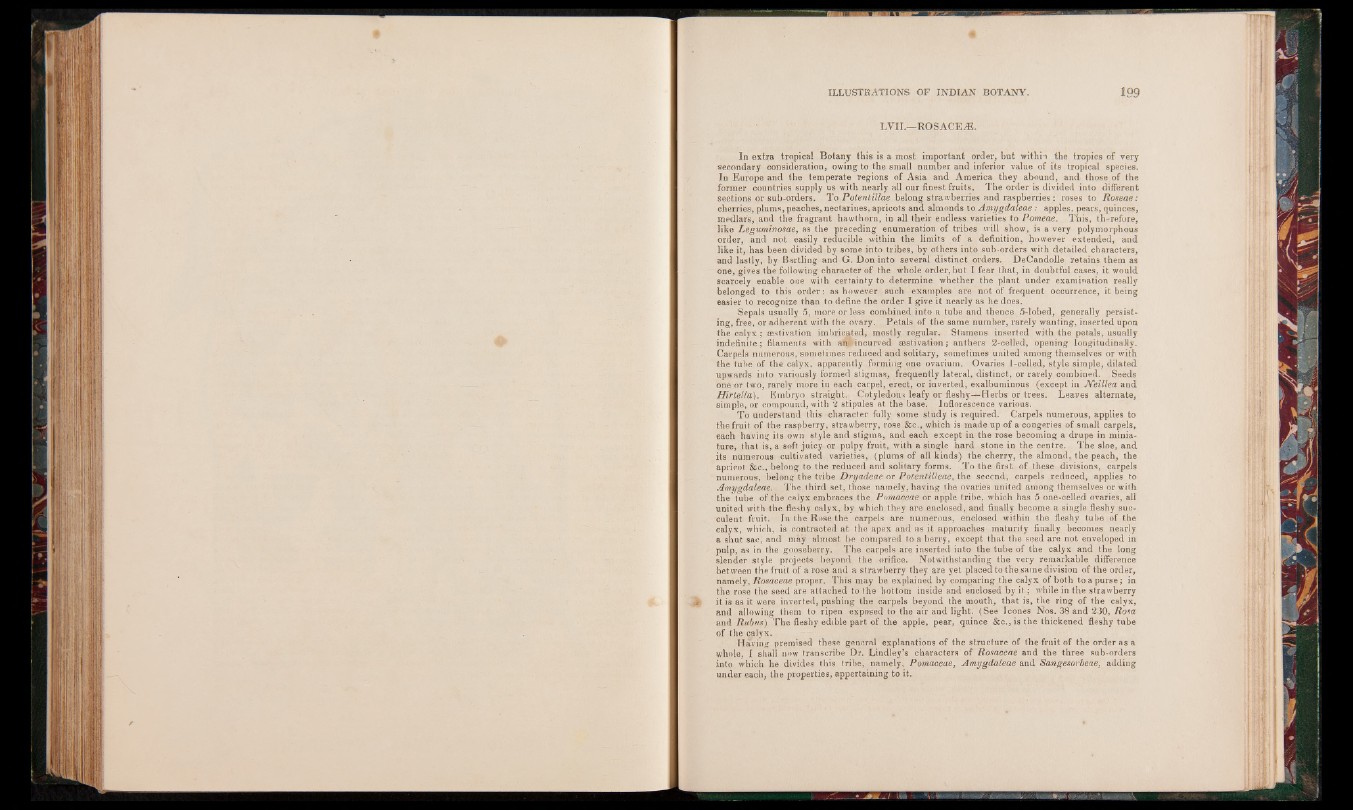
LVII.—ROSACEÆ.
In extra tropical Botany this is a most important order, but within the tropics of very
secondary consideration, owing to the small number and inferior value of its tropical species.
In Europe and the temperate regions of Asia and America they abound, and those of the
former countries supply us with nearly all our finest fruits. The order is divided into different
sections or sub-orders. To Poten tilla e belong strawberries and raspberries: roses to R o sea e :
cherries, plums, peaches, nectarines, apricots and almonds to Am y g d a le a e : apples, pears, quinces,
medlars, and the fragrant hawthorn, in all their endless varieties to Pomeae. This, thrrefore,
like Legumivobae, as the preceding enumeration of tribes will show, is a very polymorphous
order, and not easily reducible within the limits of a definition, however extended, and
like it, has been divided by some into tribes, by others into sub-orders with detailed characters,
and lastly, by Bartling and G. Don into several distinct orders. DeCandolle retains them as
one, gives the following character of the whole order, but I fear that, in doubtful cases, it would
scarcely enable one with certainty to determine whether the plant under examination really
belonged to this order: as however such examples are not of frequent occurrence, it being
easier to recognize than to define the order I give it nearly as he does.
Sepals usually 5, more or less combined into a tube and thence 5-lobed, generally persisting,
free, or adherent with the ovary. Petals of the same number, rarely wanting, inserted upon
the calyx ; aestivation imbricated, mostly regular. Stamens inserted with the petals, usually
indefinite; filaments with an*? incurved aestivation; anthers 2-celled, opening longitudinally.
Carpels numerous, sometimes reduced and solitary, sometimes united among themselves or with
the tube of the calyx, apparently forming one ovarium. Ovaries 1-celled, style simple, dilated
upwards into variously formed stigmas, frequently lateral, distinct, or rarely combined. Seeds
one or two, rarely more in each carpel, erect, or inverted, exalbuminous (except in N e ille a and
H ir te lla ). Embryo straight. Cotyledons leafy or fleshy—Herbs or trees. Leaves alternate,
simple, or compound, with 2 stipules at the base. Inflorescence various.
To understand this character fully some study is required. Carpels numerous, applies to
the fruit of the raspberry, strawberry, rose &c., which is made up of a congeries of small carpels,
each having its own style and stigma, and each except in the rose becoming a drupe in miniature,
that is, a soft, juicy or pulpy fruit, with a single hard stone in the centre. The sloe, and
its numerous cultivated varieties, (plums of all kinds) the cherry, the almond, the peach, the
apricot &c., belong to the reduced and solitary forms. To the first of these divisions, carpels
numerous, belong the tribe Drya d ea e or Potentilleae, the second, carpels reduced, applies to
Amygdaleae. The third set, those namely, having the ovaries united among themselves or with
the tube of the calyx embraces the Pomaceae or apple tribe, which has 5 one-celled ovaries, all
united with the fleshy calyx, by which they are enclosed, and finally become a single fleshy succulent
fruit. In the Rose the carpels are numerous, enclosed within the fleshy tube of the
calyx, which, is contracted at the apex and as it approaches maturity finally becomes nearly
a shut sac, and may almost he compared toaberry, except that the seed are not enveloped in
pulp, as in the gooseberry. The carpels are inserted into the tube of the calyx and the long
slender style projects beyond the orifice. Notwithstanding the very remarkable difference
between the fruit of a rose and a strawberry they are yet placed to the same division of the order,
namely, Rosaceae proper. This may be explained by comparing the calyx of both to a purse; in
the rose the seed are attached to the bottom inside and enclosed by it; while in the strawberry
it is as it were inverted, pushing the carpels beyond the mouth, that is, the ring of the calyx,
and allowing them to ripen exposed to the air and light. (See leones Nos. 38 and 230, Rosa
and Ru b u s) The fleshy edible part of the apple, pear, quince &c., is the thickened fleshy tube
of the calyx.
Having premised these general explanations of the structure of the fruit of the order as a
whole, I shall now transcribe Dr. Lindley’s characters of Rosaceae and the three sub-orders
into which he divides this tribe, namely, Pomaceae, Am yg d a lea e and Sangesorbeae, adding
under each, the properties, appertaining to it.